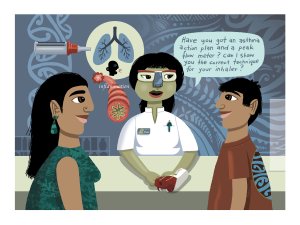Academic pharmacist Nataly Martini discusses the medical management of asthma in adults and adolescents, which has evolved to prioritise early anti-inflammatory treatment. She also explains how to improve patient outcomes by proactively identifying poor asthma control and supporting equitable access to education and treatment
Solutions for dealing with stress and burnout
Solutions for dealing with stress and burnout

The burnout crisis among pharmacists and other health workers doesn’t look like it’s going away anytime soon. Paulette Crowley spoke to mental-health lecturer Fiona Moir about dealing with stress
If it’s not COVID-19, it’s copayments; if it’s not workforce issues, it’s wildly angry customers. Wherever pharmacy staff turn these days, they’re up against it, and it’s probably not going to change anytime soon.
Fiona Moir lectures in mental health and communication skills at the Department of General Practice at the University of Auckland. She also provides education for the Evolve programme at the Pharmaceutical Society of New Zealand. Acknowledging burnout is the first step in dealing with it, Dr Moir says.
“Many people will blame themselves for being in the burnout state. It’s fine to be there and not give yourself a hard time about it.”
Dr Moir says Maslow’s Hierarchy of Needs is a useful tool. A psychology model that ranks basic needs from the bottom of a pyramid up – physiological, safety, love and belonging, esteem and self-actualisation – it can help people work out how stress affects them.
After their basic needs are met, some people will criticise themselves for not doing things that are higher up the pyramid and blame themselves for the position they’re in, she says.
“We can have a negative voice telling us we should be doing more or better.”
Although resilience helps in dealing with relentless stress, it can also be used as a weapon. Blaming yourself for not coping better will not help, Dr Moir says.
“It’s very easy to say you should be more resilient or should be using this or that technique...but it’s important to remind yourself what has happened and that you’re in a system or environment that is causing a lot of distress and pressure.”
She says doing what you realistically can is important, but there is a limit to that when you’re in a system that perpetuates burnout. “You need organisations and system- and national-level responses as well as the individuals trying to help themselves and others.”
Eighty per cent of burnout is caused by system failure, she adds.
“It’s the dysfunctional, overloaded system that’s to blame, not the person. You’re putting people in an impossible situation with three people’s workloads…you give hem a lot of angry customers, and then you tell them, ‘Oh well, if you’re not coping you should be more resilient.’ This is completely unhelpful and inaccurate.”
Burnout usually builds up over time, but symptoms can feel like they’ve shot out of nowhere.
“It can feel quite sudden. But, actually, it could have been building up over a year or more.”
Dr Moir explains that symptoms fall into three strands – stress, emotional exhaustion and connection to others. We are most attuned to picking up emotional signs, and connection to others tends to appear later in the cycle. A lack of connection can present as depersonalising patients to their symptoms, feeling detached from life and becoming cynical. People can also have a sense of being unproductive and not achieving.
The opposite of burnout is not resilience – it’s engagement
In Evolve training, which she’s taught for 15 years, Dr Moir stresses the importance of recognising early warning signs of burnout so action can be taken early.
Noting physical signs, such as an upset stomach or skin problems, is easy, but behaviours are also important to track. “Have your spending patterns changed, or your use of alcohol?”
Basic self-care, such as a healthy diet and getting enough exercise, is key. But being aware of how stress affects you is the precursor to making a plan to look after yourself.
She says some people might stay up late working, which could interrupt sleep. “So, if you know you tend to do that, make sure your lights are out at 10.30pm.”
Taking a break or a holiday also seems like an obvious choice but could be a temporary fix. “If you go on holiday, your symptoms will go away but then if you come back into the same dysfunctional system, your symptoms are likely to recur.”
So, what to do, besides fixing a system that realistically won’t change quickly? Dr Moir says telling yourself and others to be more resilient is not the way forward. “The opposite of burnout is not resilience – it’s engagement. This is a state where you feel dedicated, invigorated and absorbed.”
Start off with small steps, she suggests. “When you’re trying to re-engage, ask yourself what is the most meaningful part of your work. What is it that aligns with your values about that job? How can you find that in the middle of all this chaos and overload? Can you still find a way to connect with a part of your job that gives meaning and purpose in some small way?”
She also suggests asking your team the same questions to try and change the working environment in small but meaningful ways.
“Depending on the size of the team, it is possible to change things around. If people can do even a small bit more of what they really like doing, it can make a big difference.”
Taking breaks is obvious but often pushed aside in the frenzy of too much work. “The needs of other people aren’t more important than your own needs. If you work all the time and do more and more, that doesn’t help you make your best contribution. There is a limit to how available you can be – you’re only one person.”
- Recognise the person is angry and try to respond, not react.
- Don’t take it personally – you’re probably not the reason they’re angry, and taking on other people’s problems gets in the way of doing your job.
- Listen fully and look at them. If it’s hard to make eye contact, look at the bridge of their nose.
- Watch your tone of voice and facial expression.
- Show them you’ve heard what they said in a non-patronising way, regardless of whether you agree with them.
- Don’t try and problem-solve until they’ve fully expressed themselves and felt heard.
- Discuss what can be done given the situation.
- Frame the discussion as you and them against the problem.
- Say what you can and can’t do.
- Offer them resources to help, such as helplines. “It gives you an endpoint to those conversations to put the ball back in their court to get some help.”







